
Is Sellerboard the right analytics tool for your E-commerce business in 2025?
In this Sellerboard review, we’ll dive into a platform that many Amazon sellers now rely on, especially as global retail e-commerce sales are expected to reach an astonishing $7.4 trillion by 2025.
With more sellers entering the market, running a profitable business takes more than just listing products.
You need real numbers to guide your next move, and that’s where Sellerboard comes in for many sellers who manage their stores on Amazon.
Sellerboard helps you stay on top of your sales, track important performance numbers, handle inventory, and stay in touch with your customers, all from one dashboard.
In this review, you’ll see how Sellerboard helps sellers handle the real work behind the scenes–like managing profit margins, tracking refunds, and staying organized with customer follow-ups.
By the end, you’ll know whether Sellerboard can keep up with your goals and help your store move forward during this major e-commerce growth.
Let’s get started and see if Sellerboard fits what you need in 2025 and beyond.
Here’s a table of contents for quick navigation:
What is Sellerboard?

Sellerboard is a powerful profit analytics tool that helps e-commerce sellers keep track of their business performance on platforms like Amazon, Shopify, eBay, and Walmart.
It connects directly to your seller account and shows you real-time data across key areas of your business.
Instead of just showing sales numbers, Sellerboard digs deeper. You can monitor your profits, ad spend, inventory levels, and supply chain data—all from one dashboard.
It shows live updates on sales, orders, refunds, ad costs, product and shipping expenses, estimated payouts, and net profit. You’ll also find all the important business metrics you need, like units sold, Amazon fees, Cost of Goods Sold, and more.
Sellerboard includes helpful tools like the Inventory Manager, which alerts you when it’s time to restock and estimates how many days you have before running out of a product.
There’s also an Automatic Responder feature that lets you set up email campaigns and send follow-ups to customers after they make a purchase.
The platform works with multiple sales channels and connects easily with tools like QuickBooks Online and Google Analytics.
With everything in one place, Sellerboard helps Amazon sellers save time, reduce unnecessary spending, and make more informed business decisions.
How Does Sellerboard Work?

Sellerboard connects directly to your e-commerce platforms like Amazon or Shopify.
After you add your sales channels, it collects important information about your orders, traffic, inventory, advertising performance, and more.
The dashboard displays key numbers live, so you can watch everything in one place.
Sellerboard analyzes this data and offers insights and suggestions to help you increase your profits.
For example, you can check profit margins for each product, discover which items sell the most, uncover hidden costs in your operations, and set prices to increase your earnings.
Sellerboard also creates automated reports and lets you download data as CSV or Excel files for further review outside the platform.
This information helps Amazon sellers recognize new trends early, manage risks, and make smarter choices to grow their business.
By showing what works and what doesn’t, Sellerboard delivers the analytics you need to succeed in e-commerce.
Sellerboard Coupons and Discount Offers
Sellerboard Features – 13 Ways Sellerboard Will Benefit You
Sellerboard helps Amazon sellers manage and grow their businesses with a full suite of features.
While its main purpose is to provide precise profit data, it also includes many other tools.
Here are some of Sellerboard’s best features:
1. Profit Analytics
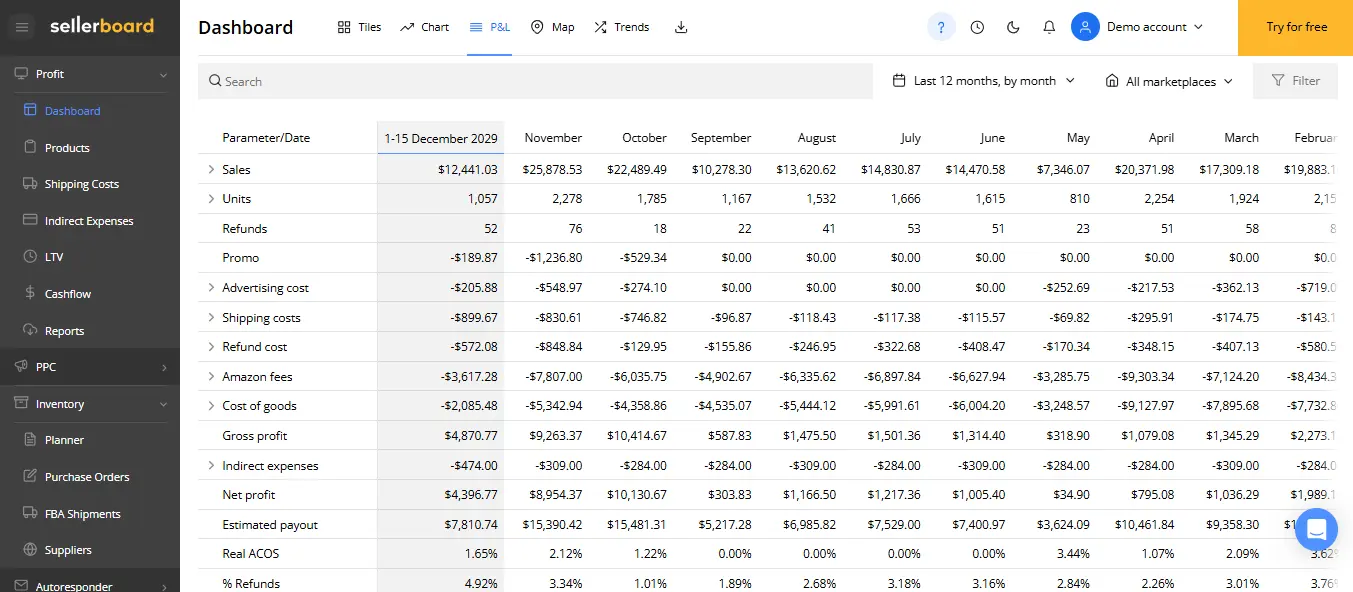
This is often cited as Sellerboard’s core strength.
It provides a real-time, detailed breakdown of your profitability by factoring in all Amazon fees (FBA fees, shipping, commissions, storage, etc.), PPC costs, return costs, promotions, and even your own fixed and variable expenses (like COGS, virtual assistant fees, office rent).
You can see net profit, ROI, and gross profit at a glance, and drill down to analyze performance by product, period, or even individual order.
This helps sellers truly understand their margins and identify areas for improvement.
2. Profit Dashboard
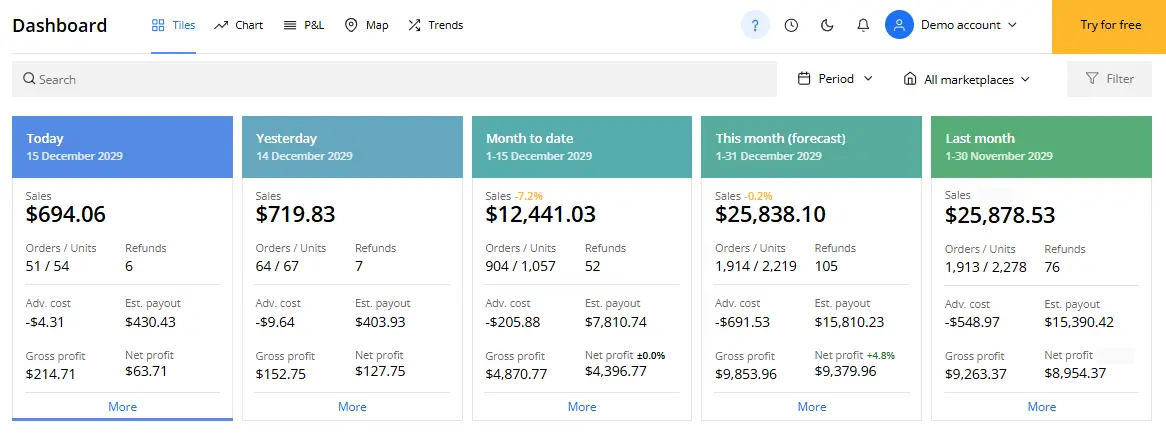
Sellerboard lets sellers customize their profit dashboard to track key performance indicators (KPIs) over different time periods.
The dashboard displays important metrics in a simple tile layout that sellers appreciate because they can select specific dates for each tile.
Sellers can also break down the data by revenue source, product line, or any category relevant to their business, which helps them understand how their operations are performing.
3. Cost of Goods Sold (COGS)
Sellerboard tracks the Cost of Goods Sold (COGS) for each product you sell, so you always know how much profit you’re actually making.
Keeping a record of item costs helps you see which products earn the most and which ones drag down your margins.
With this information, you can focus on what’s working and avoid products that hurt your bottom line.
4. Return Statistics
Tracking product returns helps e-commerce sellers see how returns affect their business.
Sellerboard breaks down the data by product and time period, so sellers can see when and where problems happen.
With this information, they can find out if something like a confusing product description is causing returns—and then take action to fix it, improve product quality, and reduce future losses.
5. Trends Dashboard
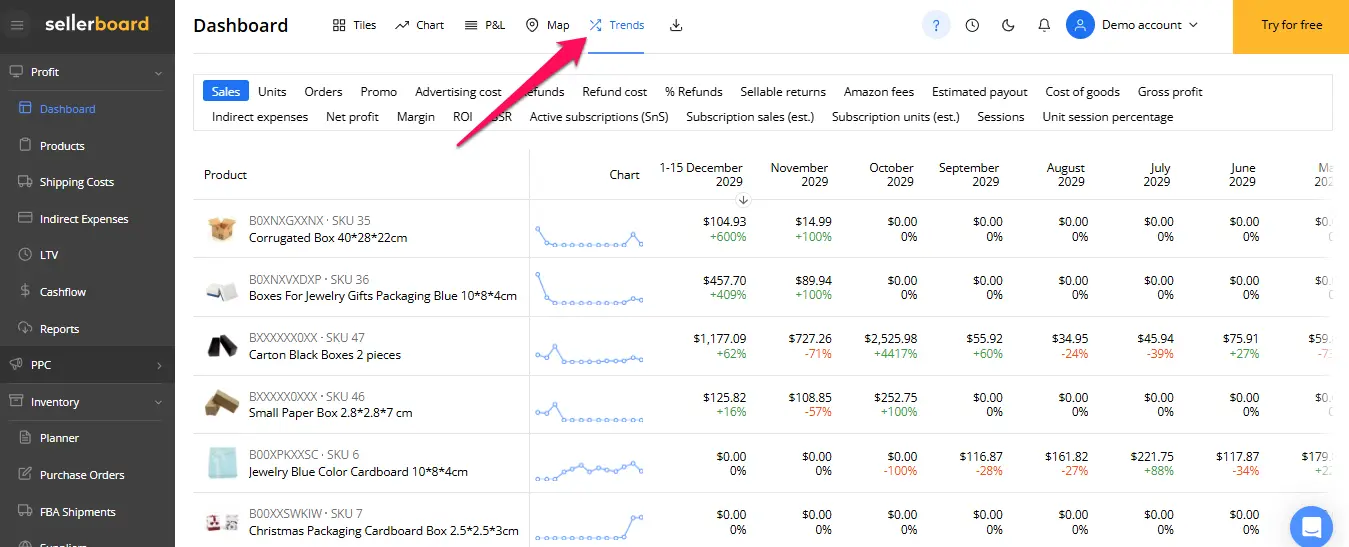
Sellerboard’s trend dashboard lets you monitor important metrics like sales, returns, and profit for each product or variant.
You can see what’s performing well and what’s falling behind, so you can focus your efforts on products that bring better results and work on improving the rest.
6. Indirect Expenses
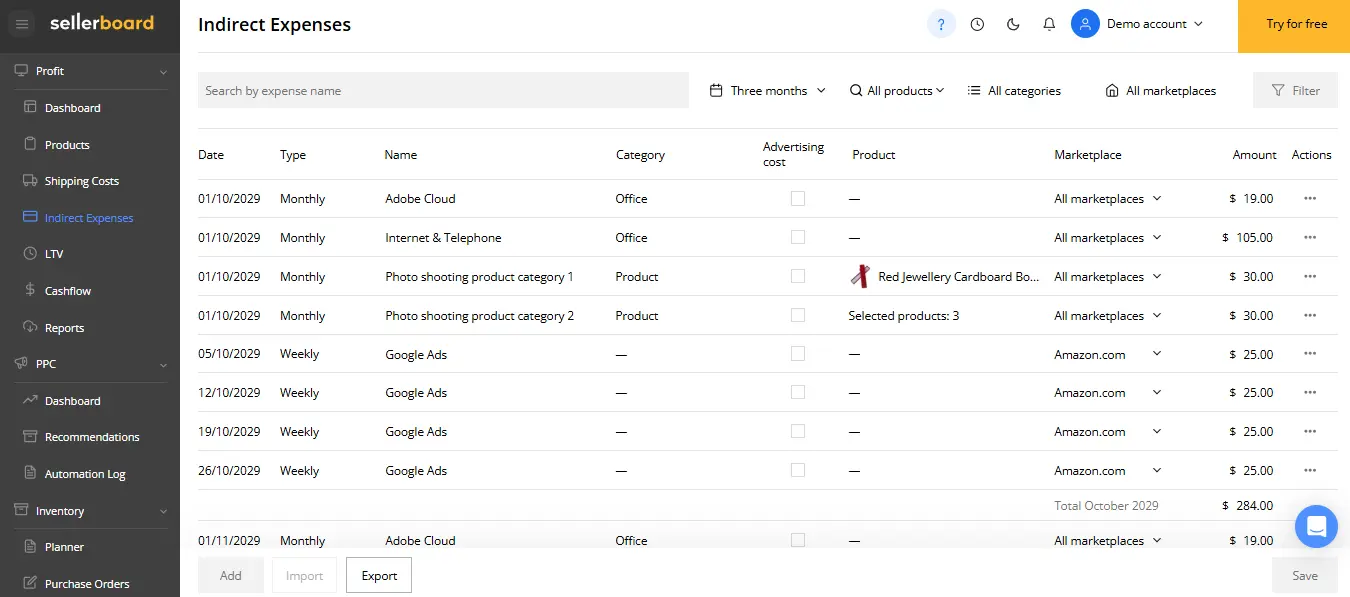
Sellerboard lets sellers add indirect expenses like storage fees and payroll to their profit calculations.
By including these additional costs, sellers get a more realistic view of how much money they’re actually making.
7. Data Export
Sellerboard lets you export all your data in CSV or Excel format. This is especially helpful if you need to run deeper analysis or send reports to your accountant.
You’ll have access to all the financial details you need, right when you need them.
8. Inventory Management
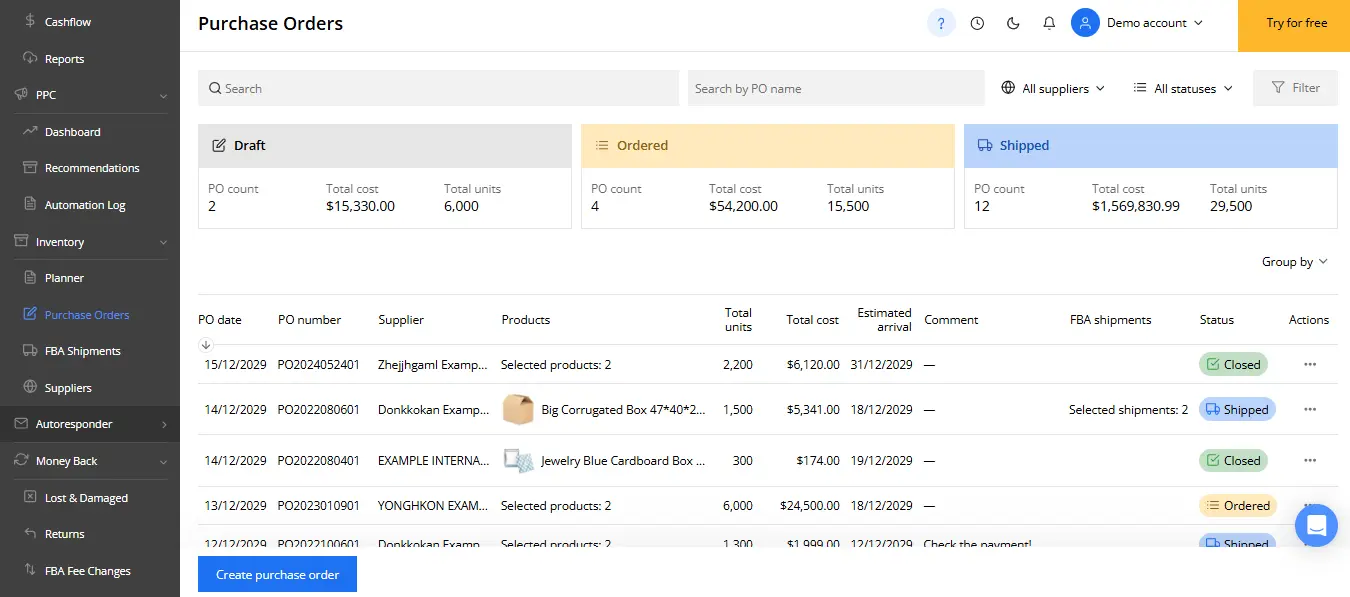
Sellerboard lets e-commerce sellers track their stock levels in real time. It shows exactly how much inventory is available so sellers can prevent running out and disappointing customers.
The system sends alerts when it’s time to reorder, based on how fast items sell and the time needed to restock. This way, sellers can restock before inventory runs low.
Sellerboard also tracks purchase orders from the moment they’re placed until the products arrive, so sellers get a complete view of their inventory process.
9. Review Requests
Sellerboard helps you get more customer reviews by reaching out to buyers who are happy with their purchase.
Since reviews play a big role in building trust and boosting sales, this feature automatically sends personalized emails to people who are most likely to leave a positive review. It looks for buyers who had a good experience and encourages them to share their thoughts.
This simple follow-up helps improve your product’s reputation and can motivate new buyers to make a purchase after reading real experiences from others.
10. Powerful PPC Optimization
Sellerboard helps e-commerce sellers get better results from their ad spend through its PPC optimization tools. It breaks down keyword performance so you can see what’s bringing in sales and what’s not.
You can find new profitable keywords and update your campaigns based on what’s actually working.
Sellerboard also handles bid changes for you by automatically increasing or lowering bids to help your ads stay in strong positions without overspending.
11. Product Listing Alerts
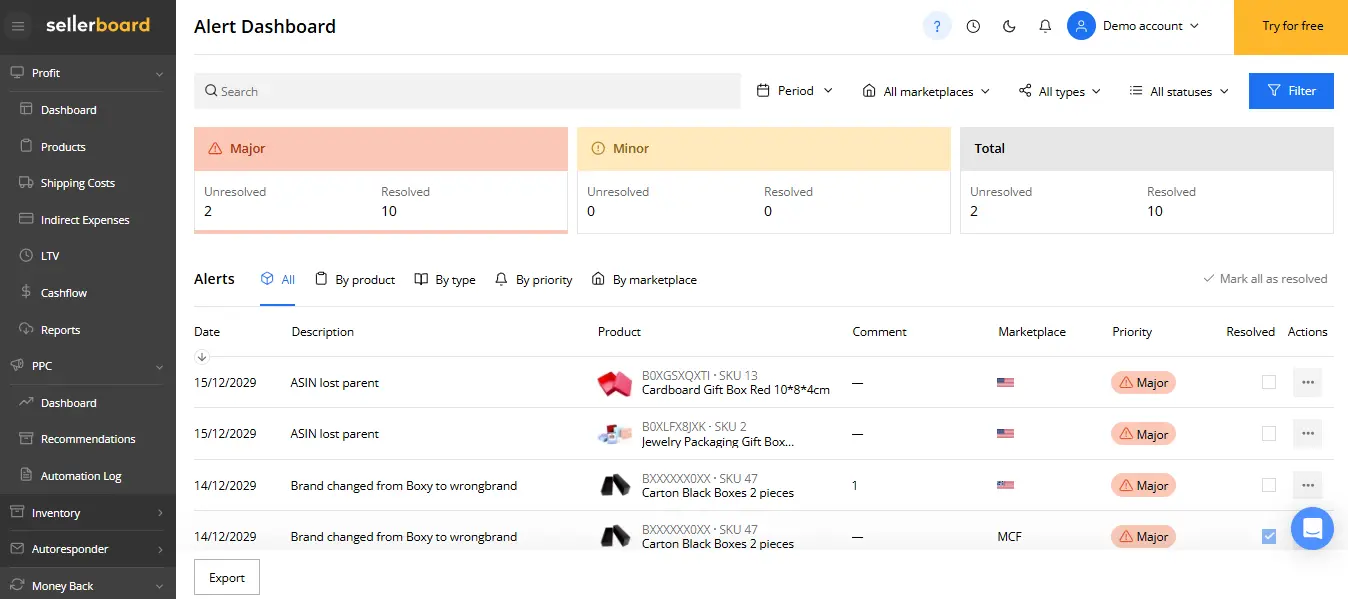
Sellerboard instantly notifies you when something changes in your product listings.
Whether it’s a price update, a new restriction, or a change in the product description, you’ll know right away.
This helps you stay on top of your listings and take quick action to protect your brand and sales.
12. Refunds for Lost Inventory
Sellerboard helps sellers get money back for inventory that goes missing or gets damaged.
Once you turn on this feature, it automatically looks for any inventory issues and files refund claims for you.
You don’t have to keep track of every lost item or deal with filing paperwork manually.
This tool takes care of the entire process, which is especially helpful if you’re managing a lot of products and don’t have the time to follow up on every loss.
13. Sellerboard Chrome Extension

The Sellerboard Chrome Extension lets you check your key sales stats right from your browser. You can see your profits, daily sales, and best-selling products without logging into your Sellerboard account.
It’s an easy way to stay updated on your performance throughout the day.
How To Start Using Sellerboard?
Getting started with Sellerboard is easy, but it is a good idea to give a 10-15 minutes to get used to it so that you can make the most out of it.
Step 1: Start Your Free 2-Month Trial
Visit the Sellerboard website and click “Try for Free” to start your 2-month trial.
You don’t need a credit card, so you can explore the platform without any cost or obligation.
This gives you plenty of time to connect your accounts, review the features, and decide if Sellerboard is the right fit for your e-commerce analytics.
Step 2: Connect Your E-Commerce Accounts
Once you’ve signed up, integrate your e-commerce accounts like Amazon Seller Central, Shopify, eBay, or Walmart Seller.
Sellerboard automatically syncs your historical data from these accounts, creating comprehensive e-commerce reports in one central dashboard.
We suggest importing at least one year of historical data to help you track long-term performance trends.
Step 3: Customize Your Dashboard and KPIs
Sellerboard provides pre-built dashboard templates that focus on key metrics like sales, profits, and advertising costs.
You can easily customize these templates by adding or removing widgets to highlight the Key Performance Indicators most important to your online business.
This way, you’ll always have a focused view of your performance when you log in.
Step 4: Add Automation Tools
You can automate tasks like sending review requests, managing PPC bids, or receiving alerts about low stock, price changes, and negative reviews.
These tools help you stay on top of daily operations without constant manual checks.
Step 5: Review the Data and Take Action
Once your accounts are connected, Sellerboard shows you all your key data in one place. Use these insights to find your best-performing products and sales channels.
Look for areas where you can improve, like pricing, ad spending, or inventory levels, and make changes based on what the numbers show.
Step 6: Export and Share Reports
You can download reports in CSV or Excel formats to analyze them further or share them with your team. It only takes a few clicks to export the data you need.
Within an hour of signing up, Sellerboard can start helping you understand your numbers and grow your business.
So, are you ready to try it out?
Sign up today and see what Sellerboard can do for your e-commerce business—all free for the first 2 months.
Sellerboard Free Trial and Pricing
Sellerboard offers four paid subscription plans based on the number of monthly orders. Each plan comes with a free 2-month trial, and if you choose the annual billing option, you get a 25% discount.
Here’s a detailed breakdown:
| Plan | Monthly Price | Annual Price (20% off) | Max Monthly Orders | Extra Seller Accounts | Access Controls | Profit Dashboard | Listing Alerts | PPC Tools | Inventory Tools | Lost Inventory Refunds |
|---|---|---|---|---|---|---|---|---|---|---|
| Standard | $19 | $179 | 3,000 | 4 | ✓ | ✓ | ✓ | ✕ | ✕ | ✕ |
| Professional | $29 | $279 | 6,000 | 6 | ✓ | ✓ | ✓ | ✓ | ✓ | ✕ |
| Business | $39 | $369 | 15,000 | 8 | ✓ | ✓ | ✓ | ✓ | ✓ | ✓ |
| Enterprise | $79 | $759 | 50,000+ | 16+ | ✓ | ✓ | ✓ | ✓ | ✓ | ✓ |
All plans include key features like access controls, listing alerts, and profit tracking. If you choose a higher-tier plan, you’ll also get access to advanced tools for PPC, inventory management, and lost inventory refunds.
These plans also support higher order volumes and let you connect more seller accounts.
-> Take a 2-month free trial of Sellerboard
Sellerboard Positives
We’ve tested plenty of analytics tools over the years, but Sellerboard made a real impact with its powerful features and simple interface. Even with detailed tracking across all our sales channels, using the platform feels straightforward.
What really worked for us is how Sellerboard pulls everything into one place with its unified reporting.
Instead of jumping between spreadsheets or multiple dashboards, we see all our key numbers on a single screen.
The custom tagging feature helps us break down performance by product lines, traffic sources, promotions, and more. It reveals patterns we might have missed otherwise.
The detailed reporting is another strong point. Sellerboard doesn’t just show profit and loss — it helps us manage Cost of Goods Sold at the item level, which makes pricing decisions much more accurate. We’re also able to see margins down to each SKU.
Beyond the reports, Sellerboard takes it further with smart automation tools. It helps manage PPC bids, sends out review requests, and supports personalized promotions — all of which help boost revenue without needing constant input from our side.
The platform also helps us stay on top of inventory and supply chain operations, which is key as we scale.
With all this data at our fingertips, we always know where things stand and what to focus on next. Sellerboard has become a trusted part of how we grow our business through data-backed decisions.
Sellerboard Negatives
Sellerboard already helps e-commerce businesses track their numbers with solid analytics. But like any tool, there’s always room to do more.
Below are a few areas where Sellerboard could grow and make the platform even more useful for its users:
1. More Shipping Carrier Integrations Needed
Sellerboard does a good job of showing order shipment statuses across different sales channels. But it could work even better by adding more direct links with carriers like USPS, FedEx, and UPS.
When Sellerboard pulls real-time data from these carriers—like transit times and shipping rates—it can help sellers choose the most cost-effective delivery options.
Sellers could pick faster shipping for urgent orders or go with budget-friendly ground shipping for regular ones.
With real-time carrier data, Sellerboard could also help automate the shipping process and save time.
2. Access to Older Historical Data
Right now, Sellerboard lets users import up to two years of past performance data from their e-commerce accounts. If it allowed data imports going back 5 to 10 years, users could analyze long-term trends with much more depth.
This kind of access would help sellers track growth more accurately, spot seasonal shifts, and see how past decisions shaped their business over time.
Two years of data is helpful, but digging further into the past would open the door to stronger insights and smarter planning.
3. Create a Unified Product Catalog
Selling on platforms like Amazon, eBay, Shopify, and Walmart often means manually matching the same product across each one.
A unified product catalog takes care of that by syncing SKUs automatically, so sellers don’t have to do it themselves.
Whenever you update a product’s title, description, or price, those changes reflect everywhere right away. This keeps your listings consistent, saves time, and helps Sellerboard deliver better insights across all your channels.
4. Competitive Comparisons
Sellerboard tracks key analytics to help e-commerce sellers understand their performance. If it added comparisons with industry benchmarks and similar businesses, those insights could become even more useful.
For instance, if a seller sees they’re earning a 15% profit margin—and the industry average is lower—they’ll know they’re doing well. It would also help to see how ad spend, conversion rates, and other key numbers stack up against other sellers.
By including anonymous data from other users, Sellerboard could show where a store stands and help sellers figure out what steps to take next.
5. Add Physical Store Analytics
Retail is changing fast, and many brands now sell both online and in physical locations.
Sellerboard already does a solid job of tracking online sales, but adding support for in-store POS data could take it a step further by showing how the entire business is performing across all channels.
With this upgrade, sellers could track inventory across different stores, understand how people shop in person, compare how each location is doing, and plan better marketing that ties both online and offline efforts together.
Even without these in-store features, Sellerboard still helps Amazon sellers understand their numbers and make informed decisions based on real data.
Frequently Asked Questions
Does Sellerboard offer a free trial?
Yes, you can try Sellerboard for free for two months. You don’t need to provide any credit card information. Simply sign up on their website to start your trial.
Which sales channels does Sellerboard support?
Sellerboard works with many online marketplaces and platforms, including Amazon, eBay, Walmart, Jet, Rakuten, and Shopify. It also integrates with point-of-sale systems, so you can manage sales from multiple sources in one place.
Can I track profit by product with Sellerboard?
Yes. Sellerboard shows you profit data for each product, so you can see how individual items perform. This feature helps you decide which products to keep, remove, or improve based on actual numbers.
How much historical data can Sellerboard import?
Sellerboard can import up to two years of historical transaction data from supported channels. This allows you to analyze your business using both recent and older sales activity.
Does Sellerboard compare my business to competitors?
No, Sellerboard does not provide direct comparisons with competitors. However, you can export your reports to perform your own analysis if you have access to other data. The platform’s primary function is to help you improve your own business through detailed internal insights.
Can multiple people use Sellerboard?
Yes. Sellerboard allows several users on the same account. The number of users and their permission levels depend on your subscription plan.
Do I need a certain number of sales to use Sellerboard?
No. Sellerboard doesn’t require a minimum sales volume. Whether you’re just starting or already selling regularly, you can use the platform to track and analyze your results.
Is Sellerboard compliant with accounting rules?
Yes. Sellerboard follows accounting regulations in different regions. It also maintains audit logs to track changes and ensure your financial records are accurate.
Sellerboard Review – Conclusion
After spending years in e-commerce, we’ve learned one thing for sure—data matters.
If you want to grow your business in 2025 and beyond, you need to make decisions based on solid numbers. That’s how you cut unnecessary costs, avoid costly mistakes, and increase your profit margins.
Out of all the tools we’ve used, Sellerboard has proven to be one of the most useful. It pulls all your sales data into one place and shows exactly how much you’re really earning.
The automation features also save a lot of time on tasks we used to do manually.
What also stood out to us is how easy it is to use. Even with all its advanced features, you don’t need a manual to figure it out. Plus, their support team responds quickly and actually helps when you have questions.
If you’re serious about scaling your store, we recommend trying Sellerboard’s 30-day free trial. It helped us get a much better grip on our numbers—and that made a real difference in our profits.
With the right tools in place, even small teams can aim for 7-figure success.
Sellerboard helped us get closer to that goal, and we believe it can help you too.






